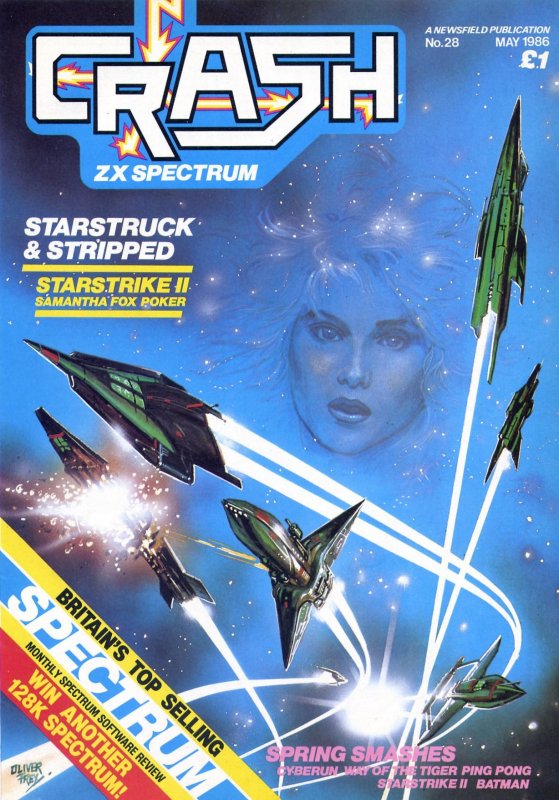

The editorial brief was simple enough: make something out of Samantha Fox Strip Poker and Starstrike II. It was an inhibiting notion, and one which Oliver left till he could no longer avoid doing the illustration. With this cover, a very popular one, it is the strength and dynamism of Oliver’s composition that makes it work at all. He was pleased with the effect, but in general he hated the illustration and felt it was rather like a poorly-licensed game — the subject was unsuitable for an exciting picture.
The month’s two big bits of news were of a very different nature. Most important was the announcement, as the issue went to press, that Alan Michael Sugar’s Amstrad had bought out Sir Clive Sinclair’s Sinclair Research, and thus the ZX Spectrum would from then on belong to Amstrad. There were very mixed feelings about this move at the time, and few people today could honestly say that many of their doubts have been removed since.
The other was that the Audit Bureau Of Circulations had declared CRASH the biggest-selling computer title in Britain, overtaking both Sinclair User and Computer & Video Games (though the latter had a marginally higher figure when foreign sales were taken into account). It was a triumph for everyone, but especially for the original tiny team that had dared to challenge the entrenched positions of so many established titles. W H Smith, before the launch of Issue 1, had said that CRASH could never really succeed as a games-only, single-user magazine; two years later we had proved them wrong.
It was a happy moment for the whole company, but before the issue was completed, something quite sad occurred. The rumbling arguments between Robin Candy and Roger Kean, which had flared up over Roger’s insistence that there should be a picture of Robin on the new Playing Tips heading because there had always been one of him there, suddenly reached flashpoint. There was an argument in the middle of the office and as a result it was decided not to use Robin any more. He was able to take a last look at his Playing Tips being laid out in the art department before leaving. However, as every CRASH reader knows, it may have been the last of Robin Candy’s Playing Tips, but it was by no means the end of Robin, though a year was to go by before his reappearance.
Max Headroom finally arrived, and though it rated fairly well (85%) it was something of a disappointment. Not so Realtime’s Starstrike II, however, with its filled-in vector graphics pushing the Spectrum beyond limits already set by pundits, sitting atop a fast and complex shoot-’em-up game. We also Smashed Ultimate’s Cyberun, often forgotten since but more of a follow-on from Lunar Jetman than anything to do with the isometrics of Knight Lore etc.
After the huge success of the film the game version of Back To The Future from Electric Dreams came as a damp squib, a mishmash plot based on the film’s action but with no game behind it. There was far more fun to be had with Imagine’s excellent implementation of Konami’s Ping Pong and Gremlin’s karate-book tie-in The Way Of The Tiger. But the game which caused most excitement was Ocean’s Batman from Jon Ritman and Bernie Drummond, who had gone out of their way to make the most densely detailed isometric graphics yet seen. And the game was good too.
Near the end of April as the May issue concluded, the three Newsfield directors, the brothers Frey and Roger Kean, took a week off in Cornwall to work out the details for a new magazine they were planning. It was to have a broad subject base and be aimed at the so-called youth market. No-one could think of what to call it, so for the time being they jokingly gave it the working title of LM — Lloyd Mangram’s Leisure Monthly. It stuck.